
Stew Redwine writes:
This time around the question Bryan put to me was twofold.
First, “Would you want to work on an article about why it’s bad for companies to $h!t on each other?”
That’s graphic. We’ll call it Comparative Advertising to take the edge off. And since there are differing definitions of what Comparative Advertising is, for the sake of this article, I’ll define Comparative Advertising a bit more broadly than others:
In Comparative Advertising, competitors are mentioned or implied in order to demonstrate why their product or service is inferior to the one advertised.
And the second question was “When did Comparative Advertising stop in advertising history, and what lessons did people learn about it?”
Now we’re talking. The History of Advertising has become a bit of a passion for me and I was curious myself to find the answers to his questions.
So why was Bryan asking me these questions? Apparently, he’d heard a couple of different service companies in the podcast space being critical of their competition in public forums. It wasn’t advertising they were doing when they decided to run down their competition but the rhetoric spurred Bryan’s questions all the same, and I answered the call.
The big difference is, with advertising you’re making a calculated choice and can plan for the consequences, both good and bad, while if you’re talking at a public event you’ve got to be able to respond in real-time. Regardless, for both the companies Bryan mentioned who chose to go on an attack, and any advertiser who has done the same with their ads, there is always the chance of backlash: and if your competitor is game that’s what you’ll be spending your time and energy on while others are innovating and focusing on what really matters, making the best product or service they can and introducing it to as many people as possible.
After reviewing a 10-year advertising war between Tylenol and Advil Federal Judge William C. Conner stated “Small nations have fought for their very survival with less resources and resourcefulness than these antagonists.” Not only is the expense great but there is also the impact on the public’s perception of the contending Brands. What does all the running down of each other really get you? One of the combatants in the Soup Wars remarked:
‘…the category has declined every year for several years… and between [Unilever and Campbell], we’re spending $60 million a year to convince consumers that our spaghetti sauce is really crappy’ – Sorescu & Gelb, 2013
So it can cost you a lot of time and money and you better think twice before you engage in it, but does it work? After looking at the history and research on Comparative Advertising here are the rules of the road:
- YOU CAN PUNCH UP, BUT YOU CAN’T PUNCH DOWN
The advantage goes to new brands and smaller brands.
(Grewal, Kavnoor, Fern, Costley, & Barnes 1997 and Beard 2008) - YOU CAN PUNCH ACROSS, BUT BEWARE
When your target is your size it causes confusion, price competition, switching, and indifference. (Pechman & Stewart 1990, Zhang 2006 and Beard 2011) - YOU CAN PUNCH THEM IN THE FEATURES, BUT NOT IN THE FACE
It’s better to focus on the features of a specific product than attack the company itself.
(Sorecu & Gelb 2013) - SOME PEOPLE JUST LOVE A FIGHT
If the audience is younger, less educated, and male you’ll get a better response.
(Beard 2008)
Using 1850 as our starting point, the advertising that most defined the latter half of the 19th Century was the almost 100% pure hype of patent medicines. These “herbal remedies” and “natural cures”, most containing alcohol and some with a spoonful of cocaine and opium to help the medicine go down, cost very little to produce. The huge margins on these products allowed extensive advertising budgets for those peddling miracle drugs. They were advertised heavily nationwide via the expanding network of railroads and newspapers and were also sold by the traveling performers that gave rise to the term “Snake Oil Salesman”.
In response to all this ballyhoo, the first generation of serious advertising professionals in the 20th Century avoided the ridiculous claims they grew up seeing in the papers and instead focused on “Reason-Why Advertising”, built on telling the truth about their advertisers with well-constructed hard-hitting copy. Famed copywriter John E. Kennedy developed the idea further and called his no-nonsense approach “Salesmanship-In-Print”. Crack open some of the legends from the era’s books, like John Caples’ “Tested Advertising Methods” or Claude Hopkins’ “Scientific Advertising”, or just look at the wording of those titles for crying out loud, and you’ll get a sense of the generally accepted approach in those days.
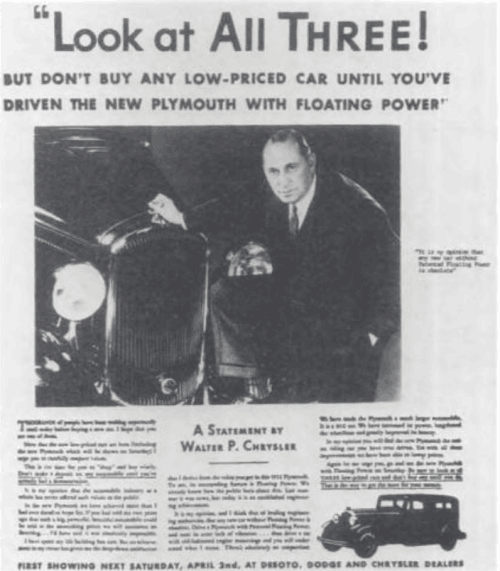
It was during this period, from approximately 1900-1950, that one of the “first” comparative ads was released by J. Stirling Getchell for the Chrysler Corporation in April 1932. The full-page ad depicted Walter Chrysler leaning over the hood of a low-priced Plymouth and explaining why it was superior to the Ford and General Motors alternatives. He even began the ad campaign the very week Ford and General Motors released their new low-priced models. But he didn’t name his competitors directly. He simply invited the reader to “Look at All THREE!”. One result of this ad, other than success for Plymouth, with sales increasing 218% and growing their share of the low-price car market from 16% to 24% in one year, and the agency winning their entire account, was the use of the phrase “Low Priced Three”, to refer to Ford, GM and Chrysler for decades to come. In 1945, Printer’s Ink columnist George Laflin, writing as ‘Aesop Glim’, summed up the era’s view on Comparative Advertising:
“Old Aesop Glim believes that – more often than not – it is sound practice to ignore your competition … Tell your own story – exclusively, positively – give your copy sound construction, sequence and conviction – and you’ll get your share of the market.”
Comparative Advertising continued its progress towards direct and eventually combative messaging with the convergence of several developments throughout the 1950s. Exploding production of all sorts of goods and services in a booming post-war economy, the advent of the Television Age, the evolving of advertising ideas beyond the tried and true “Reason Why” approach of the old school, including Bill Bernbach’s revolutionary approach of putting copywriters and art directors in teams of two, “Big Idea” advertising taking hold, and Rosser Reeves’ development of the USP, as memorialized in his 1961 book, Reality in Advertising. It all meant you could sell more stuff to more people and had to figure out new ways to do that with a particular focus on what made your product or service “different” from the competition in an increasingly cluttered market.
In the early 1970s, the floodgates of Comparative Advertising were opened when the FTC started actively encouraging it. And the advertisers obliged. In short order, Comparative Advertising turned into combative advertising and all-out advertising wars. This caused President Reagan to exclaim, “Kids these days! You give an inch, they take a mile!” He didn’t say that, at least not on the record. What we do know is that he signed new trademark legislation, the Trademark Law Revision Act of 1988, to make it easier to sue a competitor who “misrepresents the nature, characteristics, qualities, or geographical origin of his or her or another person’s goods, services, or commercial activities.”
Previous to the 1988 revision, the guiding law for Comparative Advertising was the Lanham Act of 1946. But it only prohibited making a false claim about your own goods, not your competitors, which further illustrates the shift in advertisers’ approach to comparative ads between the first and second halves of the 20th Century. Fred Beard found this change when looking at almost 100 years of Printers’ Ink and Advertising Age articles, among other sources, and concluded: “The belief competitors should be ignored almost entirely disappeared from the literature in the second half of the 20th century.”
Over the past 100 years the evolution of technology, culture, and policies have set up increasingly favorable conditions for Advertising Wars to take place with the concentration of them occurring in the latter half of the 20th Century. From Cola Wars to Console Wars to Burger Wars to Soup Wars and many more, a tremendous about of time, energy, and money has been spent attacking competitors by advertisers with moderate to enormous budgets.
Like most advertising tactics, Comparative Advertising works in some scenarios better than others and always comes at a cost. If you’re a perennial underdog, like Pepsi and Burger King, I suppose you can keep on doing it forever. Or, if you’re a challenger, like Plymouth’s “Look at All THREE!” or the 21st Century’s darling “Get a Mac” campaign, you can invite people to make an honest comparison with an earnest appeal, in the case of the former, and humor, in the case of the latter. And they both did it without ever mentioning a competitor by name.
So do you use this tool? I can’t tell you what to do when it comes to your advertising, but history and common sense are on the side of Punching Up, at least for a time, unless you’re content with remaining an underdog, for all time. Otherwise, consider the advice from over 100 years ago in a 1903 Printer’s Ink article and speak to people’s hearts and minds in this way:
“Talk success in your advertising, ignore competitors, and make your offering of vital interest to the people whose trade you seek.” (Beard 2011)
Now, before you go, we’ll take a look at some examples of Comparative Advertising post-1950.
1957
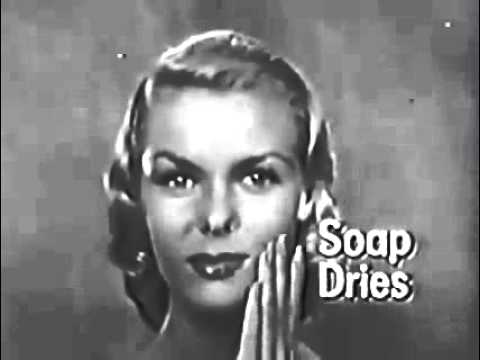
Dove vs. Ordinary Soaps – Categorically Different
✊ PUNCHING UP: The first TV advertisement for the Dove beauty bar encouraged the viewer to compare Dove soap to ordinary soap. As the ad says, “Every bar of new Dove is one-quarter cleansing cream. Ordinary soap dries your skin, but Dove creams your skin while you wash.” Similar to “Try All THREE!” it is inviting the viewer to make the comparison themselves and determine which is better without directly naming a competitor.
1962
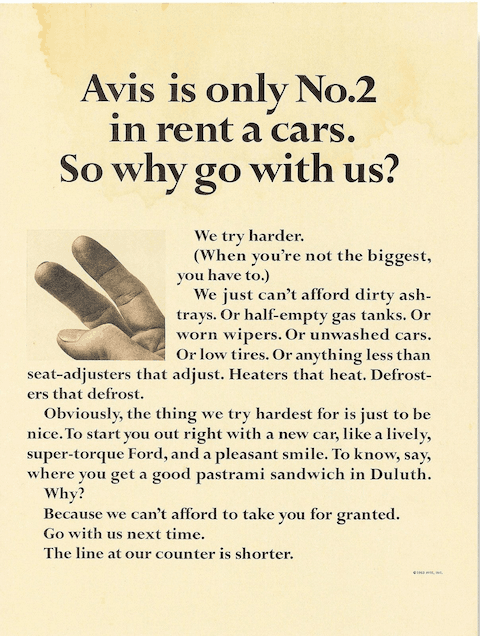
Avis vs. Hertz – Almost There
✊ PUNCHING UP: DDB’s famous campaign for Avis is counting on the reader knowing who the #1 in rent a cars is, but doesn’t name them. Again, no direct mention of the competitor and if you look closely this ad doesn’t even have an Avis logo on it because DDB’s Art Director Helmut Krone was dedicated to NOT using logos in his ads. Almost 60 years later Avis is number 3 but the tagline still guides their ethos summed up in their own words “the car rental company that must constantly prove itself to be as good as the No. 1, again and again.”
1975

Pepsi vs Coke – Challenged Challenger
✊ PUNCHING UP: There may not be a more iconic example of directly challenging a rival throughout all the different Advertising Wars. Pepsi’s 1975 “Pepsi Challenge” increased their market share, was verified by Coke, and has been replicated in a recent simulation. But Pepsi has never unseated their rival. As Matthew Yglesias put it in his Slate article, Coke won the cola wars because great taste takes more than a single sip.: “Pepsi works as such a great example of a challenge because despite decades of efforts, none of its different slogans or logos or celebrity endorsements has ever put it in first place.” Oh, and one last advertising history tidbit, it could have been the Brad’s Drink Challenge.
1982

MCI vs. Bell – The Proof is in the Parody
✊ PUNCHING UP: Thanks to Bill McGowan’s iron will and the use of microwave technology MCI could offer lower long-distance prices than AT&T’s monolithic “One system, one policy, universal service.” that was delivered via landlines. In one of their many comparative ads, MCI took a comedic approach by making a parody of AT&T’s Bell System ad from the 1970s that included the tagline “Reach out and touch someone.” In the original Bell spot a mother is having an emotional moment because she was able to talk to her child via Bell long-distance. In the MCI parody version of the spot the wife is also having an emotional moment, but it is because of how much the long-distance call cost. The spot concludes with the line, “Sure, reach out and touch someone, just do it for a whole lot less.”
1992
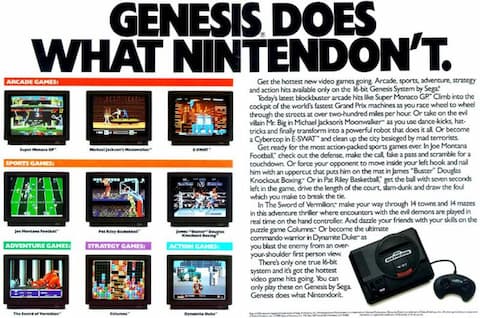
Sega vs. Nintendo – Losing the Long Game
✊ PUNCHING UP: In the 2020 documentary Console Wars Paul Rioux, Executive VP, Sega of America states early in the film, “Whenever you’re at war you always hit the guy in the mouth as hard as you can, if you can’t hit him hard you might as well not even fight.” But just because you hit hard doesn’t mean you win the war. Sega introduced itself in 1992 with intentionally combative advertising and rocketed to 45% of the US video game market by 1993. Nintendo’s position at the time is summarized in the film by George Harrison, Director of Marketing, Nintendo of America, “You just try not to respond to those kind of things. You treat them as though they’re doing that as though they’re desperate.” And at the end of this Advertising War, that was really a technology war, Nintendominated.
2006
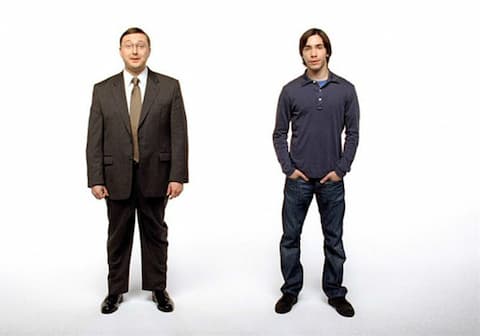
Mac vs. PC – Mr. Nice Metaphor
✊ PUNCHING UP: AdWeek named this set of 66 ads the Campaign of the Decade 2000-2010 for good reason. Apple was already known for taking shots at their competitors. But in the “Get a Mac” campaign, starring Justin Long and John Hodgman, Apple used humor and simple comparison instead of the aggressive imagery of their famous 1984 Super Bowl spot that took direct aim at IBM. But neither called out a competitor by name. The “Get a Mac” campaign is a Masterclass on how to do Comparative Advertising well and helped shape Apple’s reputation and catapulted their sales to new records. As for Intel bringing Justin Long back in their comparative ads in 2021? Like Sprint resurrecting Paul from Verizon’s “Can you hear me now?”, that may be a bit too inside, Intel.
2016

GM vs. Ford – Comparison Adds Sales
🤜 PUNCHING ACROSS: Motor City is no stranger to Comparative Advertising, especially with GM targeting Ford, like in their 2012 Super Bowl spot. And in 2016, when GM decided to compare their steel truck bed to Ford’s aluminum, they not only saw an increase in their sales, but an even greater increase in Ford’s. In a June 10th, 2016 Forbes article, Dale Buss reported, “Ultimately, of course, Ford can point to the scoreboard: Sales of all Ford F-Series trucks through May were up by more than 7 percent compared with a year earlier, and up 9 percent in May. Meanwhile, sales of Silverado were up by only 1 percent for the period, though GM said that in May it experienced ‘the lowest incentive spend and the best-managed inventories in the segment.’ ”
2018
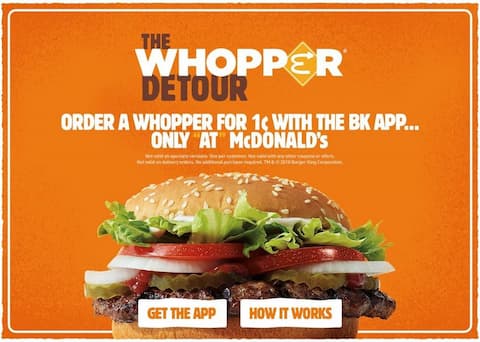
Burger King vs. McDonalds – Forever Underdog
✊ PUNCHING UP: Another long-time rivalry is Burger King vs. McDonalds. It most likely continues to work for Burger King because they’ve never left their place as an underdog. Even though one of Burger King’s more recent comparative ad campaigns, “The Whopper Detour” won them a Grand Prix in 2018 it’s going to take a whole lot more for Burger King to ever truly ascend to the Burger Throne. In Forbes Company Rivalries video, “McDonald’s vs. Burger King: Breaking Down the Burger Wars”, they sum it up like this, “While advertising is important, it’s just not enough to compete with McDonald’s revenue – the truth is that industry competition fuels innovation. As these brands compete for market share they continue to evolve new ways to appeal to and satisfy customers.”
2021
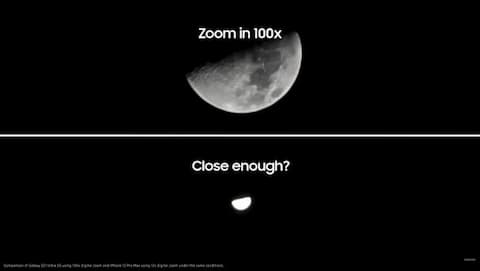
Samsung vs. Apple – Feeling Features
✊ PUNCHING UP: The final example on the timeline is from 2021 with Samsung taking on Apple. This set of Samsung ads include a side-by-side product demonstration, though it’s with Samsung on the top of the screen and Apple on the bottom, and kicks off with text on screen stating something any smartphone owner feels, “Your phone upgrade shouldn’t be a downgrade”. From a market size standpoint Apple is over 2x as big as Samsung, as of Q2 2021. So we have another underdog challenging the market leader. Samsung has a reputation for trolling Apple for the past few years but will they grow to the point they outgrow the favorable conditions for Comparative Advertising that being an underdog creates? To me, it looks like they want to be on top.
What do you think? Hit the Yappa image below and let us know.
Rel’s Recs

This week, Arielle Nissenblatt of Earbuds Podcast Collective recommends Womanica, from the Wonder Media Network, hosted with Simplecast and measured by Chartable.
Womanica is one of the first and longest-running shows from the Wonder Media Network slate. It was recently rebranded from the original name: Encyclopedia Womannica. The goal of the show is to bring listeners the story of a different woman from throughout history. Each month is themed. Host Jenny Kaplan delivers quick, succinct episodes, packed with facts about women who you might not be aware of, but definitely should be. This month’s theme is Indigenous Women, in honor of Native American Heritage Month.
Market Insights – with ThoughtLeaders
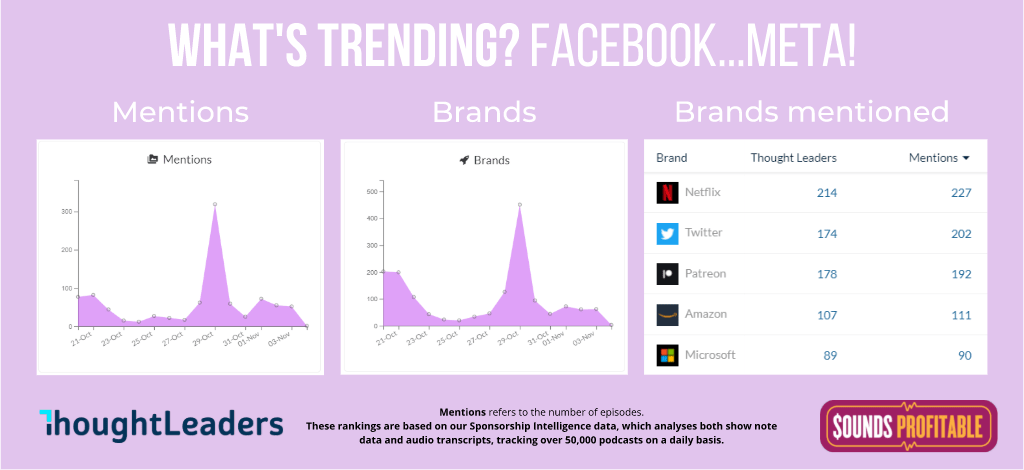
Noam Yadin, Content and Social Media Manager at ThoughtLeaders joins me this week to share insight into current trends:
The biggest news of the last week – Facebook is now Meta. Since October 21st, there were over 941 mentions of ‘Facebook’ and ‘Meta’ by 806 podcasters, with an obvious spike on October 28th when Mark Zuckerberg unveiled the new name. The podcast channels that released the most content around this topic: Focal Point Radio Broadcasts.


















































































































































































































